Brief, Handout
Oct 28 2020
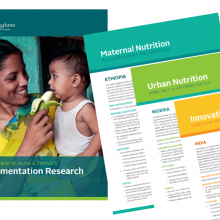
An overview of Alive & Thrive's implementation research
Alive & Thrive's implementation research spans its program areas, seeking to answer "how" to implement effective interventions and policies. Active studies are detailed in the attached documents.
Journal article
Jul 16 2020
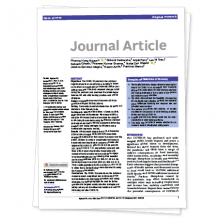
Stop Stunting in South Asia. Improving child feeding, women's nutrition and household sanitation
This overview paper summarizes and builds on papers from the Stop Stunting Conference of 2014, advocating to focus on child feeding, women's nutrition, and household sanitation as investment areas to prevent child stunting in South Asia.
Journal article
May 07 2019

Maternal nutrition practices in Uttar Pradesh, India: role of key influential demand and supply factors (Nguyen PH., 2019. Maternal Child Nutrition)
Despite strong policy and program commitment, essential maternal nutrition services are not reaching enough women in many countries.
Brief
Oct 01 2018
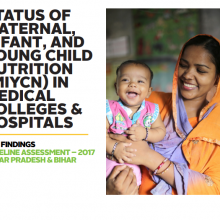
Status of maternal, infant, and young child nutrition (MIYCN) in medical colleges and hospitals: Baseline assessment (2017) in Uttar Pradesh and Bihar
Despite a favorable policy environment for maternal, infant, and young child nutrition (MIYCN), frontline delivery of critical MIYCN interventions has been a sustained challenge in India’s public health nutrition programs.
Brief
Feb 07 2017
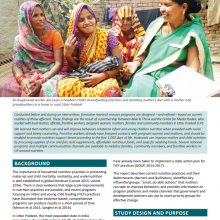
Nutrition practices in Uttar Pradesh (UP): Results from a formative research study
Alive & Thrive conducted formative research to better understand the nutrition practices in Uttar Pradesh. We found that mothers can and will improve behaviors related to infant and young children nutrition when provided with social support and timely counseling.
Brief
Feb 07 2017
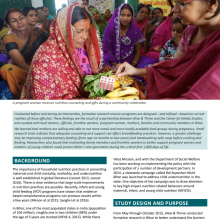
Nutrition practices in Bihar: Results of a formative research study
Alive & Thrive conducted formative research to better understand the nutrition practices in Bihar. We learned that mothers are willing and able to eat more meals and more locally available food groups during pregnancy. Read our formative research brief to learn about other findings.

